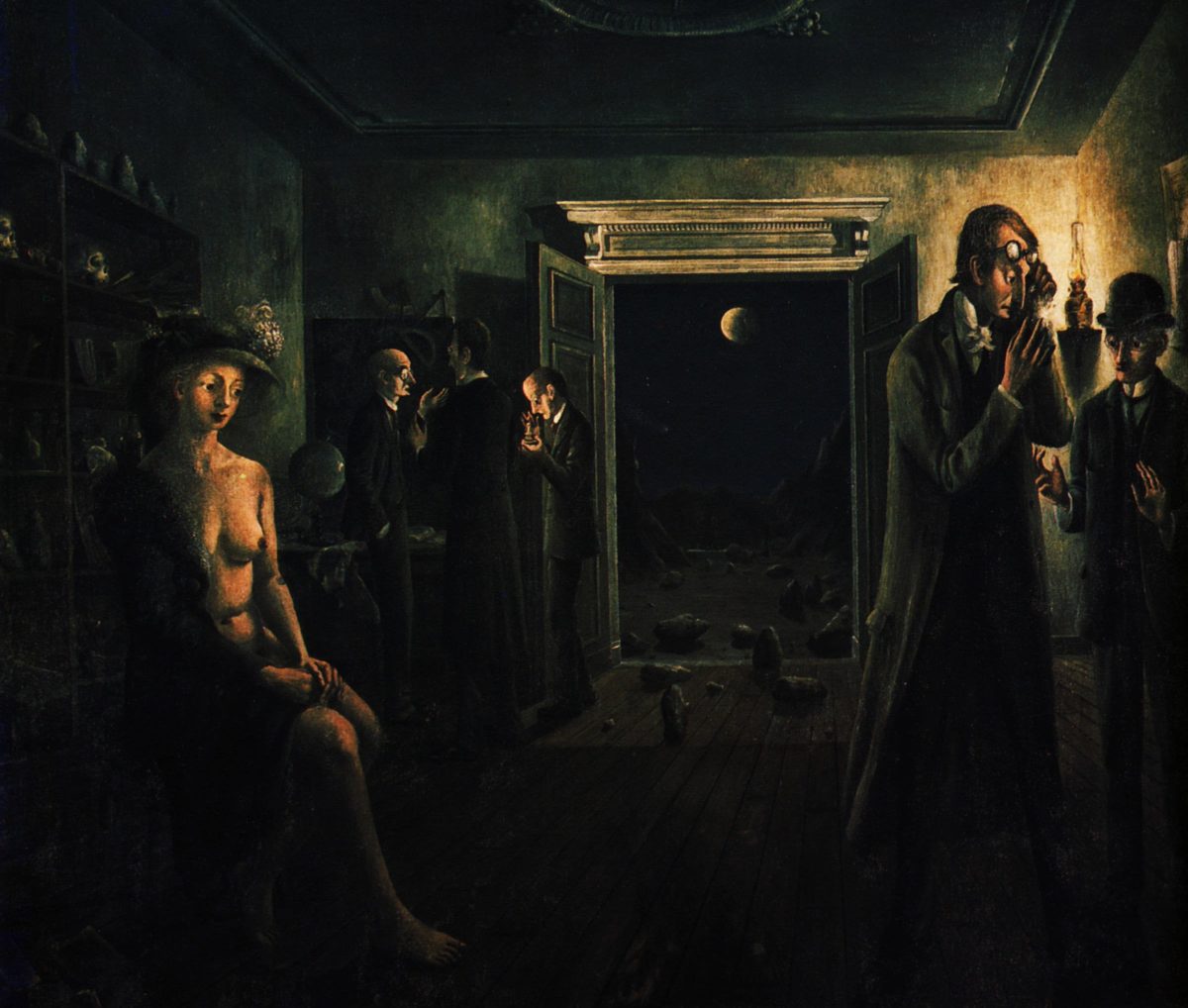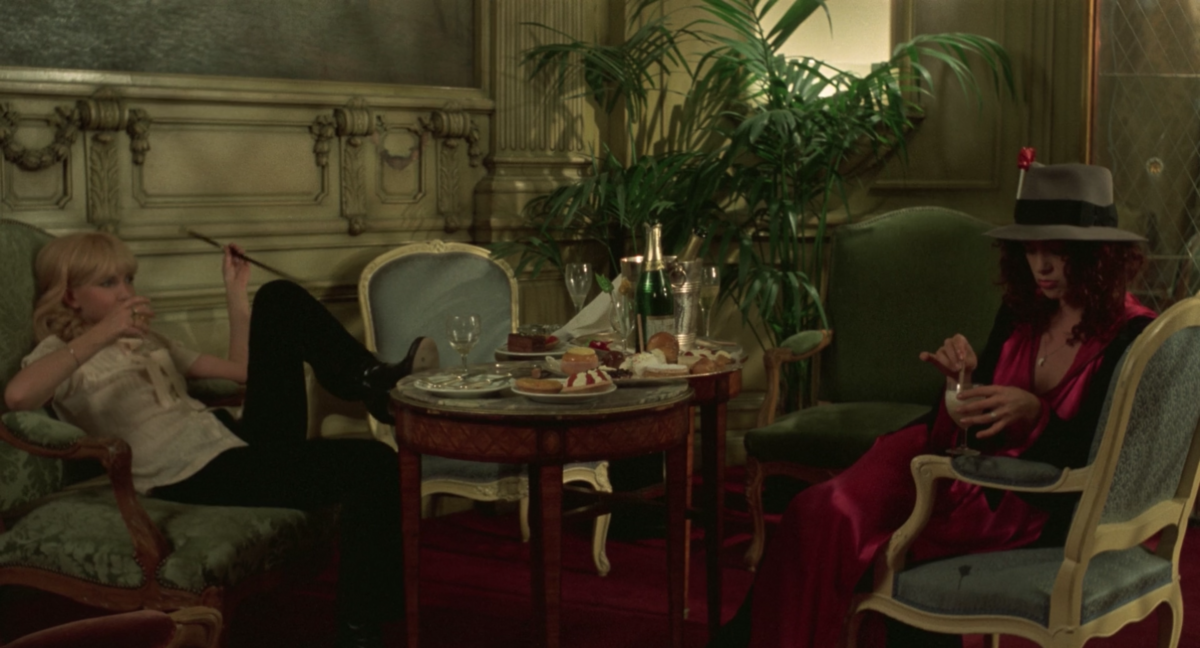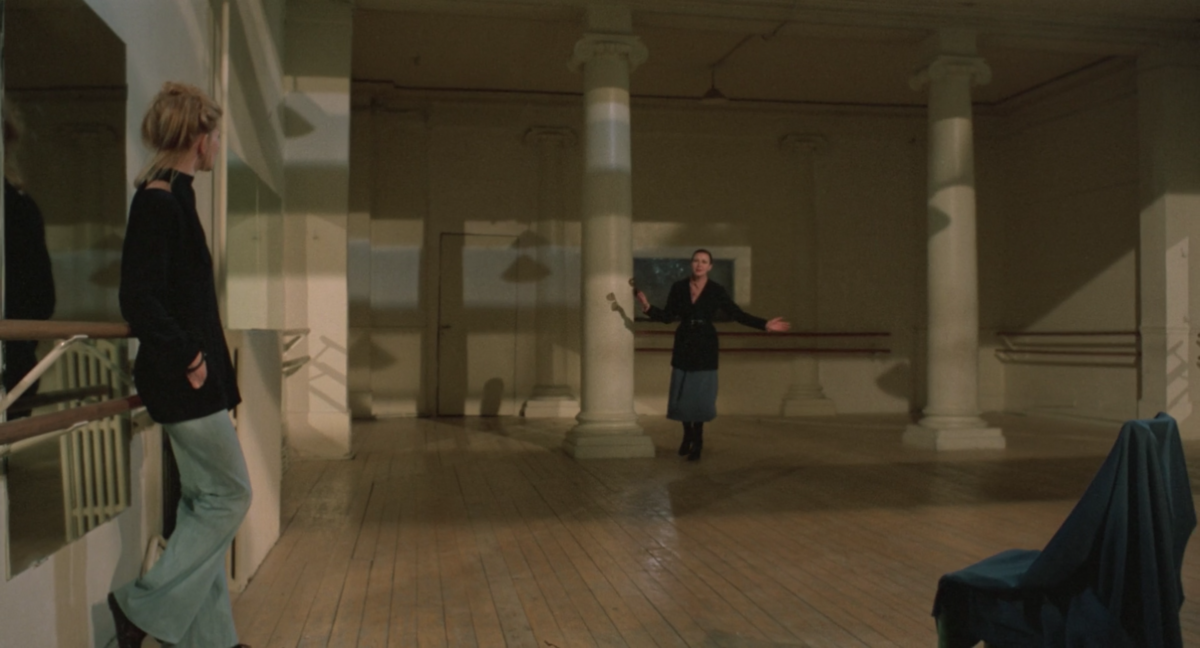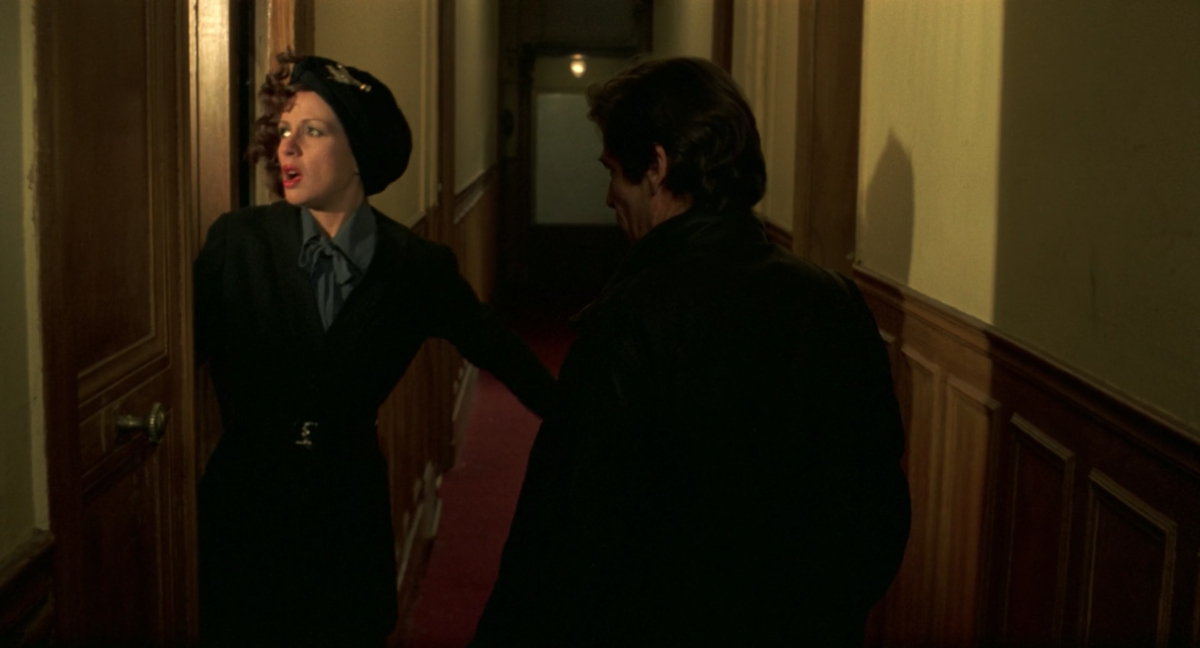In loving memory of Hermine Karagheuz
Duelle (Jacques Rivette, 1976) begins with Lucie (Hermine Karagheuz) managing the desk of a hotel at night. For lack of clientele, she is balancing on top of a large ball, practicing circus tricks, her brother Pierrot (Jean Babilée) doing back flips in the hotel lobby with her. The ball is dark blue, a beautiful moonlit night sky blue, or that seems to be the association gently imposed upon the viewer by the preceding title card: “Paris – la dernière nuit de nouvelle lune de cet hiver-là.” The lyrical connotation is only further endorsed by the small silvery circles that embellish the ball—little stars in that sky—and the glooming blue-hued darkness of the lobby. Night has entered the room. Lucie moves hesitantly, she stumbles, yet the edges of her mouth bear witness to her headstrongness as she stands up on the ball and eventually gets it rolling—a rather adequate metaphor for her role in the film. She remains the character we can more or less identify with, the one accidentally getting mixed up in some strange otherworldly business absolutely worth poking your nose into. Enter on the other hand Julie Berto and Bulle Ogier. We don’t know they’re goddesses yet, but their seamless steps betray an easiness, an agelessness, a plan—they float. The two never arrive, they appear: in hotels, greenhouses, aquariums, gambling rooms, dancing halls, staircases, subway stations, … Berto, as Leni, Goddess of the Night, enters the film in the first few minutes, in that same hotel lobby that fits her character like a glove. Leni makes a deal with Lucie: the former is looking for a man, the latter agrees to guide her towards him. During the closing of the deal, the circus ball is visible in the background, at the top of a flight of stairs, well-lit from above. The two women are positioned so that the ball lands perfectly between them in the opening of the door, mimicking Paul Delvaux’s Phases of the Moon II (1941) thus softly introducing the surrealist-existentialist atmosphere of the film, made very explicit through references to Jean Cocteau. In any case, Delvaux and Rivette share their love for misty and dark spaces, suspiciously quiet, as if something is constantly on the verge of happening.


The following scene introduces Ogier, as Viva, Goddess of the Sun. Dressed extravagantly in a glimmering golden coat, complete with a black hat, she walks down a large racecourse betting hall where an abundance of sunlight falls through tall windows. Moving through it with her accomplice, the two follow Pierrot walking with another woman, eying and smiling at each other like two cowboys assuming their position, not speaking a word. At the end of the scene—which lasts rather long for nothing to really happen—Ogier stands still, facing the camera in an almost empty hall, not so much painting a Delvaux, rather invoking Vilhelm Hammershøi’s chamber paintings where the sun enters similarly empty spaces (albeit in more domestic settings).
Although the film quickly moves from space to space, never quite establishing a center, these two subsequent scenes, one for the moon, one for the sun, open the curtains to a bare stage of sorts, a theatrical event in which mortals and gods perform a shadow play against an array of colorful infinis, each set at the same time of day as Delvaux’s paintings—somewhere around nightfall. On the stage, the characters dissemble and sustain a single plot line that appears trivial next to the tensions, questions, spectacles emanating from their gestures and movements. They are what enlightens us as to what it means to be a mere mortal being—on a screen, on a stage, on a dance floor—and it is here that we learn how to move if we wish to turn away from our ultimate confinements in time and become gods. Although the queens, in their turn, convincingly portray the appeal of our earthbound existence.
Stage-less-ness and semi-circular spaces
At the narrative center of Duelle, there is no theatrical performance, in contrast to Paris nous appartient (1961), L’Amour fou (1969) and Out 1 (1971). Duelle shows theater from the inside. It is an off-stage, highly choreographed film where the performances of the actors are not split up into different layers of fiction. The spectacle moves in the real, experiential world, where a myth of Rivette’s making breaks the film in half: some of the actors (the mortals) are cast into a detective story, a murder mystery, a treasure hunt. The other half, Berto and Ogier (the goddesses), play in a fantasy film, on a quest for a powerful gemstone, to their characters a recurring—I would almost say traditional—event. The two halves allow for no single living, breathing center, instead drawing focus to the dynamics between the lot of them: the blue (then red) gem is the heart of the film, passed along the characters by Pierrot (carrying the pierre). He is Lucie’s brother, every other woman’s lover, Cocteaudian dancer and somehow half-man half-god (a satyr?) moving like a centrifugal force around the women.
The two semi-circles here discerned not only indicate a split of character-types. Many spaces as well are arranged so that we appear to be looking into a curve, the camera complementing that curve in its course (around a casino table, around a tree), drawing even more circles in its trajectory. When the circles appear to come to a closing (often in encountering a mirror), they don’t. They flow over into other circles and we are caught in a loop, despite the seemingly straightforward plot. A loop of movements and time overflowing that restarts the 40-day carnival cycle the queens spend on earth, attempting to collect the gemstone so they (and their respective skies) can stay. These circles in Duelle are made visible in every way: the goddesses move in large loops in their respective scenes, Ogier and her accomplice drink champagne and eat cakes whilst switching seats around a table, Berto spins in quick, small turns in the ballet class. Even in the most complex space, the bar with its many corners, poles, mirrors, stairs, tables, (semi-)circular shapes are drawn by the slow tracking of the camera. These sequences stand in stark contrast with the ones where mortal Lucie leads the way, forcing William Lubtchansky and his camera to make harsh cuts that complement her hastiness.


Where the theatre and circle as motives meet, a ritual space unfolds that marks some beginning, some ending, at the center of which something changes (or not); an arrival in this world, a possible departure from it, of gods or mortals. Duelle, entirely along the lines of The Living Theater, suspends all distinction between life and theater. Duelle is not a film about a theater, it is about the theater, especially inspired by the vivid ritualistic theater scene of the 1960s with The Living Theater as one of its key exponents. Focusing on corporeality, on ensemble work and shared experiences, Duelle is a most intimate and ambiguous account of the matter, but if one looks close enough, it becomes clear—in bodies, movements, decors. Bulle Ogier was trained as an actor in the tradition of The Living Theater, Berto, Garcia and Karagheuz as well worked in the theater, all of them familiar with Brecht, with corporeal performance studies and with Antonin Artaud, who inspired the newly found ritualistic theater and its attempts to awaken the spectator, to draw them in—disparate, corporeally focused theatrical traditions that left their mark on the film at hand.
The ritualistic character of Duelle becomes visible in the shamanic repeating of the same lines over and over again (“deux et deux ne font plus quatre, tous les murs peuvent s’abbatre”). It becomes even more visible when Leni and Jeanne/Elsa (Nicole Garcia)—an innocent mortal trying her luck—move around a disco ball, as if they will commence an actual duel, or, alternatively, as if they’re about to engage in la rumba, coincidentally also the name of the bar they are at. The rumba doesn’t suggest a quick-paced party but rather a romantic get-together, it is not a spectacle of fast tricks, high jumps and smooth slides. Rather, it is an ode to large gestures, slow moving limbs, a sensual tableau of two bodies spinning around, seducing one another.
The ritual of Duelle is held (or pulled apart) in a choreography of such movements: the limits laid out by Rivette (and by the Lubtchanskys, the second one being Nicole, who edited the film), the movements mostly filled in by the actors. A non-hierarchy and cocreation between creator and actors similar to that of ritualistic theater. Ogier remembers her working relationship with Rivette as a “gentle complicity”. In the end, the film is also meant to address, incorporate the spectators, who should be (physically) affected by what they see, forgetting what day it is, or at least what time of day it is. This is the case for the 1960s ritualistic theater, and what Rivette wanted in cinema, as he wrote in the 1950s:
Through his participation in certain corporeal acts, the spectator merges with and is incorporated into the actor (and can thus, in a roundabout way, unconsciously imitate his successive psychological operations, to the extent that his acts depend on them).
Rivette moves through the theater in his first few films, then finds a way to penetrate the theater from the 1970s onwards. Deleuze lingering: Rivette’s cinema of theater is very distinct from the theater of theater. In 1990, for Rivette the actor is still the singular most important of all cinematic elements, the one able to perform himself, to establish an act and to express a creator’s idea all at once.
Where desires meet: gestures & movements
If Rivette sees tension in the eyes, he wishes to see the hands, if he sees the hands, he wants to see the entire body, so he tells Serge Daney in Claire Denis’ Rivette, le veilleur, a 1990 documentary on the filmmaker-critic. Lubtchansky’s tracking shots make soft turns and maintain a certain distance. Rather than dismembering the actors’ bodies, rather than cutting in time, the integrity of the actors’ selves is respected or commanded: they constantly have to act with their entire bodies for the integral length of the shot. They become bearers of time—figures of history—or in the words of Mary Wiles: “drawn from the past, embodiments of the present.”Mary M. Wiles, ‘“Scenes from Parallel Lives”: Jacques Rivette and Marguerite Duras’, The Cine-Files 12, 2017.
To keep body and time integral, Rivette almost entirely refuses close-ups in Duelle. Rather than trusting in montage—he claims he lacks the confidence—the metteur en scène maintained the unaltered whole of the image (perhaps afraid to lose something). He shows impetus and response in the same frame, not withholding a single twitch in the elbow, a turn of the head, a tension in the feet. As Tom Paulus writes, there is a distinct Brechtian undertone here, especially when Rivette writes that the actors need to be inserted for gestures to become acts (and even more so when you know about Rivette’s intention to engage the spectator). It is here that the heart of cinema can be found for Rivette. He chose to lay bare one potential outcome, one probability, one incomplete experience, filled with movements that supersede the character, the role, the actor. Rivette almost seems to repeat Aristotle’s poetics, not necessarily favoring probable impossibilities, but rather exciting irrationalities over improbable possibilities. The principal role of the actor is to express this potential, this incomplete experience, for the spectator to complete in his own dynamic, physical presence. The actor becomes the “nodal point of gestures”. Rivette leads us from Deleuze’s “movement is the essence” to Giorgio Agamben’s “gesture is the essence” of cinema (in which movement is a given). And of (that) essence is not the swaying of Berto’s hand filled with bribing money, but how it sways.
The distancing effect is ultimately decided upon in the moment where the experiential creative process—a method of “openness and instability”, “putting itself constantly at risk” as Adrian Martin captures it—is put to an end by Rivette, the master, enabling him to “sculpt it into a form and reflect on it”. There are many histoires revolving around the film because of the intense collaborations Rivette fostered, often deciding on projects by thinking of the actors first, but the film inevitably only captures one materialization of it. Only these reels are developed and turned into a visible print. The other remain open memories (or phantoms) of a certain image, a scent, an idea. In an interview with Rivette in Film Comment, Lauren Sedofsky wrote that Rivette “participates in a contemporary acceptance of phenomenological incompleteness,” which Sedofsky read in the difference between Out 1 and Spectre, two entirely different films made from the same material. But phenomenology is by definition a philosophy of movement and action, of experience, meaning that Spectre need not show that Out 1 could just as well have been another film.“So ließe sich der Möglichkeitssinn geradezu als die Fähigkeit definieren, alles, was ebensogut sein könnte, zu denken und das, was ist, nicht wichtiger zu nehmen, als das, was nicht ist.” (Robert Musil, Der Mann ohne Eigenschaften) The incompleteness can be read (perhaps more constructively) as a collection of potentialities, which Sedofsky reads in Rivette’s work anyhow, incompleteness being inherent to the phenomenological thinking practice. Perhaps Duelle digs even deeper into this phenomenological incompleteness than Out 1 does. There is no necessity for proof of these other potentialities, just as there’s no secondary stage to complement a first existence in Duelle. The actors are accomplices in the Heideggerian hermeneutic circle of the film, deriving meaning, sense and action from the script they were given, adding specificities to it in gestures and postures, refiguring the script, refiguring the film, (refiguring cinema).
Returning to Brecht, there is no psychologizing tendency to these acting bodies (especially those of the fantastic figurines), instead they present or ‘quote’ bodily gestures in the same way they present the text—never comfortably their own. Goddesses Ogier and Berto attempt to move just like us regular mortals to try and seduce young human women to retrieve a stone for them. But they absolutely fail to do so, their movements are nothing like those of Lucie who, guarded as she is, knows better than to trust them. Let alone those of Jeanne/Elsa, the tall, sad blonde who gets seduced by each and every one of them, blinded by a morphing desire (for a man, then a diamond). In her attempts to emulate the postures of the goddesses, on the other hand, Elsa remains awkwardly stiff and it comes as no surprise that she is the first to exit the scene.
Still with Brecht perhaps, but also with Barthes (“an irreducible plural”) and especially with Bazin (“matière esthétique brute”) in mind, Rivette suggested text to be part of a film as ‘matter’. The script for Duelle was written on set by Marilù Parolini and Eduardo de Gregorio, commented or approved by Rivette not long before the shooting of the scene began. The sparse and at times impressionist use of text in Duelle does not represent, does not explain nor construct. The lines picked from Cocteau’s play Les Chevaliers de la Table ronde (1937), woven throughout the film, are events in their own right, self-expressive material or miniature word-spectacles. The dialogue earns its own spot next to the music, the bodies, the spaces. The text becomes spatialized matter in the mise-en-scène, only it must pass through bodies (Deleuzian actor-mediums) to be sincerely present, just as the music is right there in the middle of the scene. According to Jonathan Rosenbaum, because the actors and musician Jean Wiener share a space, “the creative expressiveness becomes gestural,” which is something Rivette himself had written early on in The Act and the Actor:
Only the actor, besides having the greatest possibilities of identification, possesses the malleability necessary for certain expression: he elevates movement to the dignity of gesture.
Text, music, body are all singular actants in a game where all keep their distance, or at least show their individuation forcefully through gestures. Look at Berto’s twirling hands, Ogier’s disturbing laughter, the semi-circling camera uncovering pianos played by Jean Wiener in rooms full of mirrors, the zebra-in-his-pyjamas-joke by Pierrot, Victor Hugo’s le rêve, c’est l’aquarium de la nuit, the row of numbers Viva repeats again and again, that bear something of the rhythmic countdown in dance choreographies. No voice-overs, no music laid over in post-production, but a theatrical totality, a mild ballet filled with pirouettes (in words and in movements).

Even though all elements are self-sufficient, it is still a game, so it occurs that text and tracking shot, gesture and sound, space and action come together, add up or double into a single signifier. In utter success, all adds up to serve the actor as the one expressive entity. Although Rivette is known as a filmmaker who relies heavily on the input of his actors, for Duelle all aspects were largely thought out and decided for them. They subjected themselves to the necessary malleability to express the gestures of Rivette’s alternative universe, his vie parallèle. But in the unraveling of the plot, the acting too shows its structure. There are moments for example, late in the film, where the lines spoken impose a particular way of acting. There’s a clear somatic reaction that follows the words uttered. When one goddess says of the other that she either can’t stand daylight (Berto; “elle ne tolère pas la lumière”) or she can’t go without (Ogier), they respond accordingly in later scenes, notably, with a significant delay. When the lights hit her face (in a décor that “reflects” her), the Queen of the Moon takes many seconds longer to cover her visage (in a medium long shot) than any instinctive reaction would demand. She responds to the character that earlier is interweaved flawlessly with the gestural actor-being of Berto. She spatializes her movements and, in the words of Tom Paulus, “overtakes her character”—of whom this attribute of a sun-allergy was probably communicated to Berto mere hours before shooting the scene. The film ends with its shamanic deux et deux and a cut to black—the possibility lingering that Duelle might start over any given moment now, endlessly looping this parallel worldDuring the opening credits of the film you can hear a train arriving (overlaid with experimental music). With the end credits, a train departs and so the cycle is complete. until it has entered our bodies so that the act might depend on us and we no longer fear phenomenological incompleteness, but rather engage in an attempt to find out where Rivette’s and our desires meet.